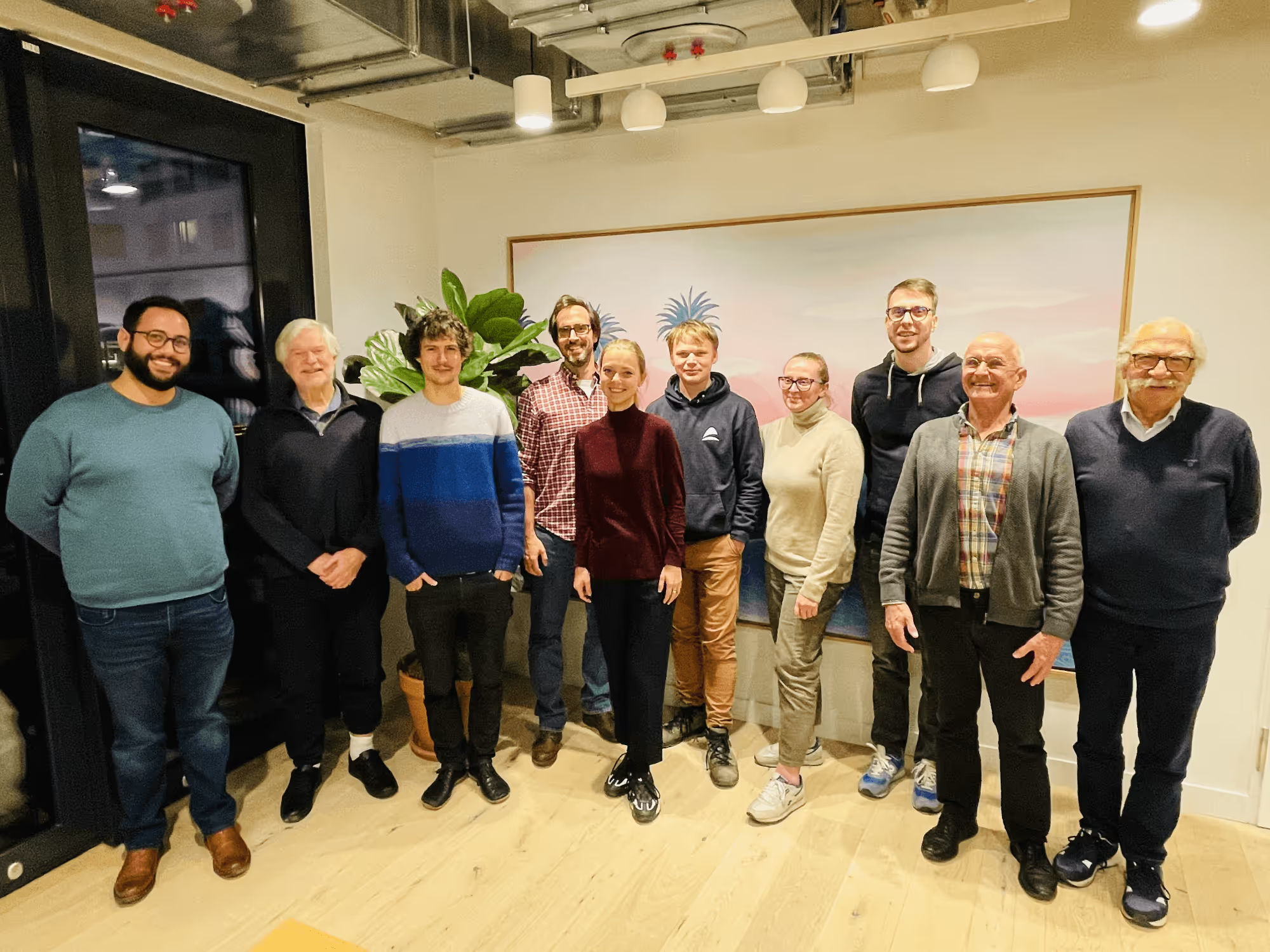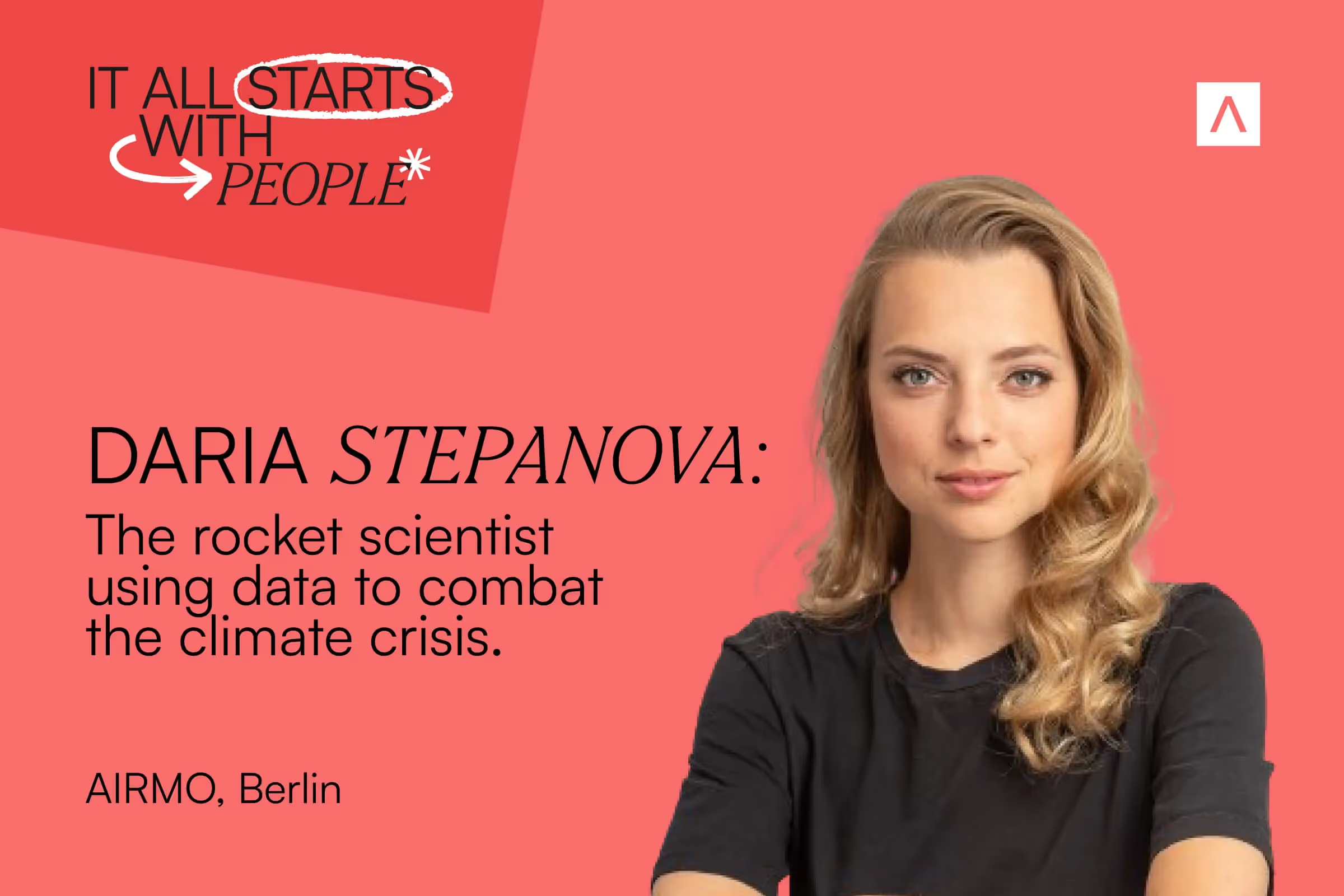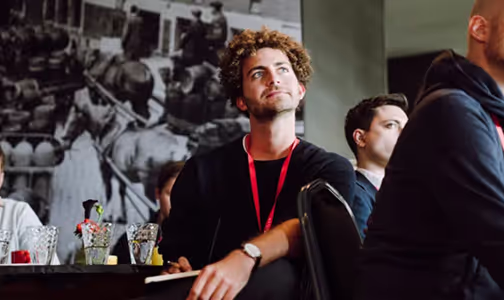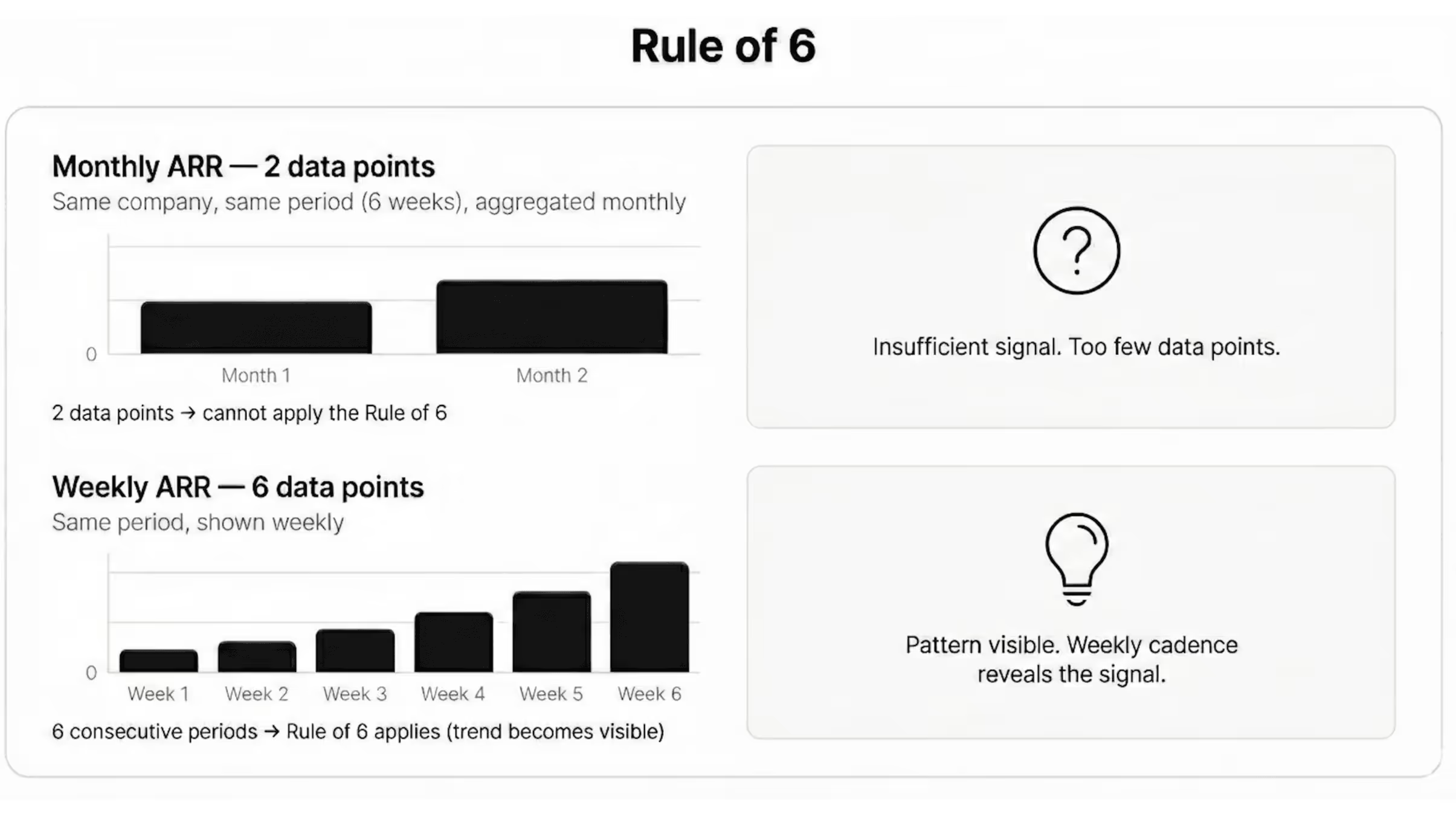Daria Stepanova, the CEO and co-founder of AIRMO, the Munich- and Berlin-based startup, is taking aim at climate change through a satellite constellation monitoring greenhouse gas (GHG) emissions across the planet. Last summer, AIRMO closed €5.2 million in pre-seed funding and is on track to launch its first satellite with the latest in GHG-detecting technology in 2025.
Deep in the barren expanse of Turkmenistan’s Karakum Desert a gas crater the size of an American football field has burned for half a century. The result of a Soviet drilling accident in 1971, the flaming pit—labeled the “Gateway to Hell”—is seventy meters wide and twenty meters deep. The Darvaza Crater has produced to date an estimated 3.8 million tons of combusted methane—the equivalent of the annual carbon dioxide emission of a household car for almost 2.8 million years.
While this noxious gas-belching oddity has become a minor tourist destination for the seventh least visited nation on earth, it is no surprise that its environmental and economic burden is now something of an embarrassment even for Turkmenistan, the world’s fourth largest producer of natural gas.
Experts have been cajoled into seeking ways of extinguishing the flames, yet it’s the escalating environmental costs and revenue losses of Turkmenistan’s stuttering oil and gas industry that most concerns the nation’s president. Research has shown that methane leaks from Turkmenistan’s two main gas fields last year caused more global warming than the entire carbon emissions of the United Kingdom.
“It’s terrible,” says Daria Stepanova, co-founder and CEO of AIRMO, a startup providing precise and close to real-time data on CH4 (methane) and CO2 emissions. “The United Nations Environment Programme works with NGOs and local entities to try to convince nations and private companies to take care of these emissions. But with Turkmenistan, for example, it’s not that easy because it’s a fairly closed country.”
Turkmenistan’s president recently unveiled a road map of measures aimed at tackling his country’s colossal gas leaks. This has paved the way for the former Soviet state to join 150 other nations that have signed the Global Methane Pledge to cut global CH4 emissions by 30 percent by 2030.
Stepanova is adamant that her company AIRMO—an abbreviation of “air monitoring”—can help drive this change by setting the new global standard for precise and continuous GHG emissions measurements. AIRMO aims to launch its first satellite—complete with the latest in GHG-detecting technology—in 2025.
“Sometimes it is more convenient for energy asset owners to release or burn methane than recycle it or use it for energy purposes. Whether it is down to dishonest behavior or faulty equipment, the path to solving this problem lies with precise monitoring," Stepanova, a 30-year-old Russian who once considered playing professional volleyball, stresses. “We need to monitor and track these emissions supporting both regulators and direct emitters. It’s a problem that needs to be approached together.”
Growing up with stars in her eyes
Born in the same Russian province of Ryazan as Konstantin Tsiolkovsky, the space research and rocket pioneer, it was perhaps written in the stars that Daria Stepanova would follow in his footsteps. “Both my parents are engineers. All my grandparents are engineers. So, I literally didn’t have any choice—I was always going to be an engineer,” she says.
Like many children, Stepanova was transfixed by space. “There was definitely a moment when I wanted to become an astronaut,” she laughs. “But I really just loved building things and seeing how they worked. It didn’t really matter if it was a satellite or a robot.” After studying at Bauman University in Moscow—at what she describes as “the best engineering school in Russia” and where she spent “lots of sleepless nights trying to figure out what’s going wrong while building hardware systems”—she founded her first company, a franchise of escape rooms.
“I found myself building lockers, devices, keys, and other stuff. Even if it was entertainment and very far from what I’m doing at the moment, it was still all about building new, complex things that no one had built before and seeing how they worked and how people used them,” she recalls.
Stepanova juggled her own business with a master’s in aerospace at Moscow’s Skolkovo Institute as well as a degree in mathematical modeling at the Moscow Institute of Physics and Technology. At this point her focus was on electronics and control systems. “But I found a new department dedicated to space at Skoltech. Until then it wasn’t on my radar, but when I saw the program and checked the professors, I found it super cool.”
So began Stepanova’s journey towards becoming the self-confessed “space nerd” that she is today. An overseas exchange program in Lausanne intensified her passion at the Swiss Space Centre. “That’s where I got hooked to move into space and to build satellites. Since then, I have not been able to stop,” she admits. “I just love the intersection of climate and space. I cannot imagine doing anything else than satellites and I’m also very inspired by taking care of our planet.”
Ich bin ein Berliner
After six years of study, Stepanova worked at the Moscow-based private space company Sputnix for a summer before moving to Berlin for a development engineer role at German Orbital Systems. During her six years at GOS, she rose up the ranks—becoming a senior aerospace engineer (off the back of studying remotely for a PhD in theoretical mathematics) then chief technological officer (CTO). Her stint as CTO was preceded by a two-month program at the International Space University in Strasbourg, a prestigious graduate-level training block for future leaders of the emerging space community.
Somehow, Stepanova also managed to squeeze in the launch of two more companies. With a friend, she helped design a type of portable electrocardiogram for astronauts, before founding Not Just A Jewel, a startup developing smart jewelry for non-violent self-defense. Despite her Russian heritage, she now identifies as a German and sees Berlin as her home. “It’s been almost eight years since I was adopted by Berlin,” she says. “It’s hard to imagine moving anywhere else.”
While she travels back to Russia once a year to see her parents—she is an only child—Stepanova more regularly meets them in places like Turkey, Azerbaijan, or the United Arab Emirates owing to the difficulties stemming from the war with Ukraine. “I’ve found a lot of compassion,” she says of her birth country’s ongoing conflict. “I found a lot of empathy towards me and my family. I have not had any problems in the workspace or personally, which I am very happy about.”
Take-off with Antler as the launch pad
At German Orbital Systems, Stepanova cut her aeronautical teeth while enjoying security and career progression. She was working with “nice budgets” towards a total of 12 small satellite missions. As CTO, she was running a team and responsible for developing further missions. In her own words, “I really loved my job.” So what made her walk away from it all to build her own startup from scratch?
“I had founded two companies before so I had an outlook as to how cool it could be to wake up every morning and know that you’re doing something totally yours while bringing your vision forwards,” she says. “I saw quite a big opportunity for greenhouse gas emissions monitoring. I believe that space-based Earth observation applications are still largely unexplored. There’s a lot we can do with space data and a lot of value to be derived from this data. These were my reasons for starting my own company.”
While many entrepreneurs embark on an Antler residency on the hunt for the ideal co-founder or even a company idea, Stepanova had her ducks in place before enrolling. Not only had she chosen what her line of business would be, she also had a company name and two fellow co-founders lined up, including a mythical figure with over three decades of experience running space programs.
“I’m not a typical example of an Antler company,” she admits. “We already had a very solid idea that my co-founder had been working on for almost 20 years. In this respect, Antler helped us kick-start the business—especially in guiding us through the fundraising process. We may have arrived where we are today but it would have taken much longer without Antler.”
Stepanova’s time in the Antler residency also helped her work out what AIRMO could do with the data generated from its cutting-edge Light Detection and Ranging (LiDAR) technology. “We joined as a team of space engineers with limited knowledge on what to do with our LiDAR and the data,” she says. “Antler helped me understand how to transform the tech, the raw measurements, and the data into customer value, how to look properly at the problem, come up with a certain value proposition, and defend and verify this proposition.”

Getting the LiDAR leader on board
Since identifying that satellites might hold the answer to what the market has been seeking with carbon footprint management, Stepanova has made stratospheric progress. Though the first satellite of AIRMO’s proposed 12-satellite constellation has yet to reach orbit, Stepanova has laid the perfect foundations for lift-off, with a stellar co-founding team with unparalleled experience.
Top-tier co-founder Dr. Errico Armandillo joined Stepanova from the outset as CTO. Armandillo is an industry expert with almost half a century’s clout working in space optics, instrumentation, and technologies. He previously collaborated on projects at the European Space Agency, where he worked for 28 years as head of optoelectronics. “Errico is a big source of my inspiration. I definitely want to be doing something similar when I’m his age,” Stepanova says of her septuagenarian colleague.
Armandillo is also, crucially, the world’s leading expert in the LiDAR instrument that provides precise and unbiased data about carbon emissions anywhere in the world and which has become the USP of AIRMO’s satellite technology. The Italian veteran brings a blend of wisdom, knowledge, critical thinking, and, above all, calm to the co-founding team.
“He is incredibly energetic,” Stepanova says. “He had his vision on how to miniaturize the LiDAR technology and was determined to continue working after he left the ESA. It did not take me much time to convince him to join AIRMO because he loves the topic and he loves working in our team. He really believes in what we’re doing and he’s the global mastermind behind the topic.”
“Climate is in our DNA”
By tackling what is arguably the single biggest challenge facing the world, AIRMO aims to transform the way we track and reduce carbon emissions globally. Investors are quickly identifying the company’s growth potential. In the summer of 2023, AIRMO closed €5.2 million in pre-seed funding, comprising €1.5 million from venture investors and a €3.7 million contract with the European Space Agency.
AIRMO’s broad range of backers is an indication that the company has what it takes to succeed as both a climate and spacetech business venture. Most notably, the contract with the ESA underlines the belief from the agency that what AIRMO is doing is not just innovative but unparalleled in the current market.
The capital will allow AIRMO to build and launch its first satellite in early 2025 following recent successful tests of its satellite technology. On top of funding the first of a dozen satellites, the pre-seed capital will be used to double the size of a team that currently employs 18 people. An ambitious target of being able to detect every GHG super-emitter event by 2030 has also been set, with AIRMO joining the “Aiming for Zero” program of the Oil and Gas Climate Initiative, the industry-led group to tackle emissions, to work on this goal.
Becoming an official partner of the OGCI net zero program is, according to Stepanova, “a testament to our commitment and progress in the fight against climate change.” She envisions an entire constellation of satellites in orbit by 2028 to monitor emissions near real time globally. “Climate is in our DNA,” she says. “In 10 years, I hope to have a team of 200 people—brilliant engineers, scientists, and software developers supporting the net zero transition and building innovative tools for earth observation.”
A key weapon in this global push from companies and governments to transition to clean energy is data, the holy grail for net zero.
“As we monitor our personal health and try to make decisions based on data, I think we should apply the same logic to maintaining the health of our planet. We should collect data and act accordingly. So many actions have been taken and regulations developed. But the one trend that I saw was that the data layer—raw and actionable data—was missing,” Stepanova explains.
From an ecological point of view, the quantification of emissions presents one of the largest challenges in the ongoing climate crisis. In other words, high-quality actionable data is needed to ensure that transparency is brought to the companies and markets at the heart of the issue. Through the company’s LiDAR technology, AIRMO aims to rethink the current understanding of GHG emissions and enable the development of more targeted, effective climate solutions.
Bringing emissions down to earth
The simplest and cheapest way of slashing the methane emissions that cause 25% of global warming is by tackling leaks from fossil fuel sites. Methane emissions are, however, much harder to estimate than regular CO2 emissions that come from combustion processes. The detection of leaks, meanwhile, is so slow they can take weeks, months, even a whole year before being identified.
That the amount of methane combusted in the Darvaza Crater roughly equates to the same amount released globally from human activities in 2019 should not gloss over the fact that Turkmenistan’s aging and poorly maintained pipelines are responsible for far worse environmental catastrophes. A recent leak released 427 tons of methane per hour into the atmosphere—the same impact as the entire emissions of France in that same time frame.
“With our solution we will be looking globally into methane emissions and we’ll be able to monitor oil and gas, energy, and other direct emitters assets very precisely. We can work with these companies to help them reduce their emissions from leakages,” Stepanova says. Currently, most methane leaks are detected through routine on-the-ground surveys—a challenging prospect given the numerous sites and millions of miles of pipes. The unpredictability of leakages makes the installation and maintenance of ground sensors at all potential hot spots impractical, while the use of drones or airplanes is costly and merely reactive.
It is only by harnessing a unique bird’s eye perspective with satellite technology that the detection of leaks can be carried out not only continuously but also as close to real time as possible—and without the need to deploy people on the ground. According to AIRMO’s research, early detection and remediation of these leaks would result in emissions reduction equal to 800,000 people flying to the Maldives and back.
How AIRMO’s star can burn the brightest
It would be wide of the mark to assume leakages and environmental disasters were confined to developing nations like Turkmenistan. One of the world’s worst polluters despite a population of just six million, the Central Asian power was responsible for the highest number of super-emitter events in the world in 2022: a staggering 184 according to the Guardian newspaper.
But the same 2022 report showed that the United States had 152 super-emitter events from fossil fuels. The three biggest “methane bombs”—oil and gas projects that would drive the planet to climate catastrophe—are located in North America. A recent report from the Environmental Protection Agency estimated that there were 630,000 leaks in US distribution mains alone.
The BBC also reported in September 2023 that a major methane leak in the UK—enough to power 7,500 homes for an entire year—had been spotted from space. The leak was detected by the University of Leeds using satellite technology from the Canadian company GHGSat, which has recently signed a £5.5 million partnership with the UK, funded by the UK Space Agency. GHGSat has attracted over $100 million in investment since launching in 2011 and currently has nine satellites in their constellation.
Other private sector companies using AI and satellite technology to combat climate change include the US-based Orbital Sidekick, which has plans to launch six satellites, and the French firm Kayrros, which detected the raft of super-emitter leaks in Turkmenistan. The presence of other thriving GHG-monitoring companies underlines the financial opportunity there is for AIRMO, which differs from its competitors because of its use of micro-LiDAR solutions in addition to spectrometer-based measurements, which significantly improve the accuracy and sensitivity of measurements, leading to faster mitigations of emissions.
The International Energy Agency estimates that global emissions are 70% higher than official reported figures—and only 9% of companies are able to measure their emissions. This creates a vast opportunity for AIRMO to thrive. “We have certain advantages compared to the other satellite companies targeting the same emissions monitoring industry due to our tech solution and our instrument design,” Stepanova says.
“Our solution will enable the lowest detection threshold, meaning we’ll detect smaller emissions and smaller leakages. With our LiDAR solution, we’ll be able to monitor emissions independently from the weather in different wind and aerosol conditions. This is exactly the data set that helps us to filter all the noises in measurements of concentrations and allows much more precise quantification compared to what exists on the market.”
Adding value to the customers
In a short period of time, Stepanova and her partners have founded a company with a clear vision and leading specialists in place covering the spacetech, software, and data collection aspects of the business. She says she is driven by her desire to ensure this expanding team remains “happy, motivated, inspired, where we learn from each other and have a cool time.”
But Stepanova's vision does not stop there.
“My personal success would be to build a product that adds fundamental value to the customers,” she explains, with a nod to AIRMO’s continuous, actionable, unbiased, near-real time data. Once the first satellite is in space, AIRMO will unroll a subscription service “selling yearly pools of credits equal to one measurement of one square kilometer with an average cost of €100 per measurement.” She says the business model will follow the model of the corporate wellness platform Gympass—“flexible and user-friendly, easy to use for different customer types.”
While AIRMO’s customers may be governments, regulators, and even bodies such as the European Commission—invested in regulation, optimizing performance, and upholding environmental standards—its primary focus will be on the oil and gas, energy, and other direct emitters companies so often painted as the “bad guys.” It’s a market that urgently needs to act: the energy sector accounts for around 40% of methane emissions from human activity.
Stepanova describes these methane emissions as “the lowest hanging fruit” when it comes to implementing AIRMO’s technology. To keep global warming to no more than 1.5°C—as per the Paris Agreement—the UN has stated that emissions need to be reduced by at least 30% by 2030 and reach net zero by 2050. As fears over global warming intensify, regulations will only get stricter.
Achieving sustainability goals through the decarbonization of their processes and the reparation of faulty equipment may be critical to the survival of many companies going forward. While the oil and gas industries are the largest emitters, they also stand to gain the most from having more reliable insights into their emissions. Green premiums within the sector have added a financial incentive, while the detection of leaks can see previously lost resources flipped into revenue. Hence the need for the best data possible.
If AIRMO can play a key role in solving the defining crisis of our time, that does not make Stepanova and her fellow co-founders climate activists. Stepanova clarifies that AIRMO is a data-based company, not an ideological one. “We need to act based on data and we need to act smartly,” she underlines.
“The transition from fossil fuels will take time. For some countries and businesses, there will be losses. The resistance coming from the sector is understandable. But sustainability should also be attractive from a business perspective. We cannot just expect [oil and gas businesses] to shut down all fossil fuel production straight away. The process should be managed smartly. If we just cut down on fossil fuels tomorrow, there will be economic problems that will be much worse than climate problems.”
Sports as the foundation of resilience
Stepanova’s determination to work with all sectors across the industry in a coordinated effort to achieve a goal is reflected in her activities away from work. When asked about her hidden talents, she casually reveals her past as a professional volleyball player. “I played in country-level competitions and I represented my local region of Ryazan in national competitions. The peak of my career was finishing second place with my partner in the Central Russian championships in women’s beach volleyball,” she says, before adding wistfully, “but that was a long time ago.”
At one point, the Olympics beckoned until she pulled the plug. “Our coach wanted to bring us to London 2012. Who knows where we would have been with two more years’ training. But we decided to put more effort into our studies. A career in professional sports is incompatible with education—especially engineering,” she says.
Playing a team sport, however, prepared Stepanova for her future career as an entrepreneur. “Volleyball taught me a lot about resilience and being goal-oriented—and, if something goes wrong, to stand up and continue pushing and being a team player.” Her days dreaming of gold may be long gone, but Stepanova still factors sport into her busy schedule.
“I do not compromise on doing sports or sleeping—they are two things I build my life around,” she says of her daily routine, which starts at 6.30 a.m. for a round of emails before breakfast. An hour in the gym after work draws a line under her office duties—although Stepanova finds it hard to switch off in the evenings. “I have lots of founder friends who have the same lifestyle. We often meet and go for dinner and talk about work. It sounds like it’s still my job. But since we’re all obsessed with what we’re doing, it’s another way of relaxing,” she says.
Rather than streaming television series or reading a book, Stepanova puts her body through the paces to give her mind a rest. “Sports really help me shut down. I do high-intensity training and if you don’t concentrate, you’re out. I do it in the evening so when all the stress of the day accumulates, I go and take it out.”
The next steps: 2030 and beyond
While news headlines can easily cause people to have more alarm than optimism about the future, Stepanova sees the changes happening now as an inevitability that needs to be managed intelligently.
“I think we should proactively change our behavior. We see climate change at AIRMO as a coordination problem. It’s a big transition that our planet needs to go through and we need to manage this transition,” she says. “We’re not scared or depressed about climate change. It’s an inevitable process. We have all the chances to minimize risks and losses—we just need to act smartly around what we do. Everyone should be participating.”
Looking forward, Stepanova sees many uses in AIRMO’s LiDAR technology beyond its “first mission” of tackling climate change. Other potential applications include wind and aerosols monitoring, the predictions of weather patterns, and altimetry—which she describes as “a super exciting field.”
The advent of air taxis from the German companies Volocopter and Lilium would certainly put a premium on precise, real-time measuring of terrain height. “If we align our vision with Volocopter and Lilium, we will need 3D maps updated in near real time. Along with proximity sensors, that’s the big topic we would like to explore after 2030,” Stepanova says. This need for reliable proximity sensors is something she believes will intensify as the number of commercial and cargo flights into space rises.
For now, the entrepreneur awaits her morning alarm with a spring in her step in her adopted home of Germany. “What makes me wake up every day is that I align totally with the mission of AIRMO,” she says. “I love the intersection of climate and space. I love building things that work. So this comes together with my motivation and inspiration.”
As for the question dreaded by so many of us at parties—“What’s your line of work?”—it is not something that Stepanova shies away from.
“I really like it. I can talk about space non-stop. I love seeing people surprised and excited [about my response]. Although space is becoming much more commercial and accessible. There are more and more people actively and consciously going in that direction. So, hopefully it will soon not be as exotic as it is today—and at every party you will meet someone who is doing something around space.”
The urgency of the problem combined with the lack of existing transparency on emissions puts AIRMO—with its ability to independently shed light on the problem around the clock—in a position of power at a time when companies and governments have legally committed to strict emissions reduction targets.
Ready to build a company that tackles a crucial problem of our time? Visit antler.co/apply and apply to an Antler residency in 25+ locations around the world.









.jpeg)


